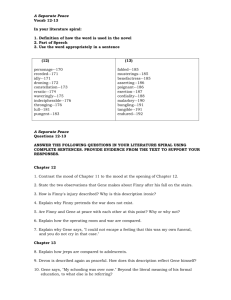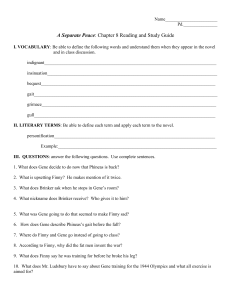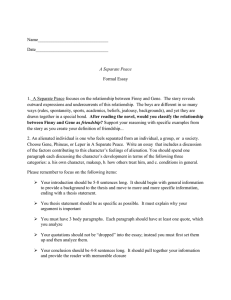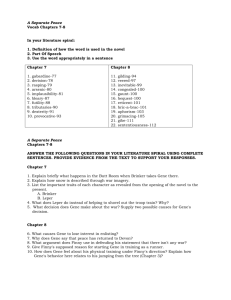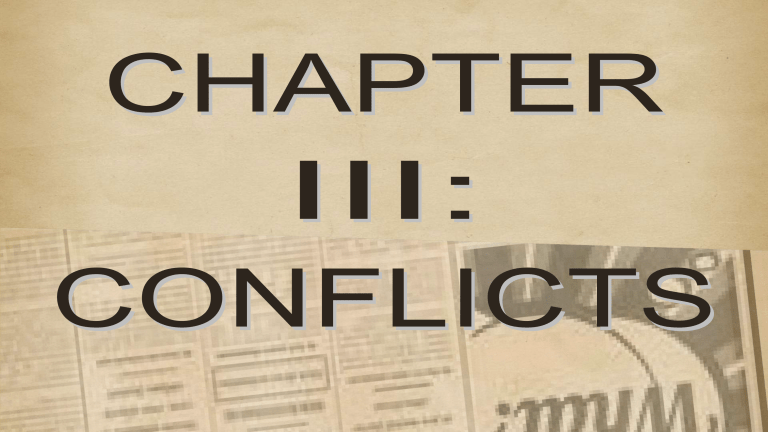
CHAPTER III: CONFLICTS A SEPARATE PEACE BY JOHN KNOWLES ABOUT THE AUTHOR: 1926-2001 He published his first novel, A Separate Peace, in 1967 Attended Phillips Exeter Academy, an exclusive boarding school in New Hampshire Knowles served as a writer-in-residence at Princeton University and the University of North Carolina After graduating from Exeter in 1945, he served as an Air Force cadet for eight months before enrolling at Yale University, where he earned a bachelor's degree in 1949. CHARACTERS Gene Forrester Finny SETTING Leper Lepellier Brinker Hadley Cliff Quackenbusfh Cfhet Douglass Mr. Ludsbury SUMMARY GENE FORRESTER, AN INTELLECTUAL STUDENT AT DEvON SCHOOL, FORMS A SECRET SOCIETY WITH HIS ROOMMATE FINNY, WHO TEACHES HIM A DANgEROUS jUMP RITUAL. GENE ENvYES FINNY'S ATHLETIC ABILITIES AND SUSPECTS HIS FRIEND IS DISTRACTINg HIM FROM HIS STUDIES. SUMMARY GENE REALIzES HE WAS MISTAKEN ABOUT THEIR RIvALRY AND jOINS FINNY FOR THEIR jUMPINg RITUAL. GENE'S KNEES SHAKE, CAUSINg FINNY TO FALL AND SHATTER HIS LEg. THE TRAgEDY IS CONSIDERED AN ACCIDENT, BUT GENE FEELS gUILT WHEN THE DOCTOR TELLS HIM FINNY'S ATHLETIC DAYS ARE OvER. HE CONFESSES BUT IS INTERRUPTED, SENDINg FINNY HOME. SUMMARY AFTER THE SUMMER SESSION ENDS, GENE RETURNS TO SCHOOL AND CONFESSES TO FINNY THAT HE SHOOK THE BRANCH INTENTIONALLY. HE RESCINDS HIS CONFESSION AND CONTINUES TO SCHOOL, WHERE HE BECOMES ASSISTANT MANAgER OF THE CREW TEAM. HOWEvER, HE QUITS DUE TO A DISAgREEMENT WITH THE CREW MANAgER. WORLD WAR II IS IN FULL SWINg, AND THE BOYS AT DEvON ARE EAgER TO ENLIST. BRINKER HADLEY SUggESTS THEY ENLIST TOgETHER, BUT GENE ABANDONS HIS PLANS. FINNY ExPECTS GENE TO REPLACE HIM AS THE SCHOOL'S SPORTS STAR, BUT GENE PROTESTS THAT SPORTS ARE NO LONgER IMPORTANT DURINg THE WAR. SUMMARY FINNY AND GENE TRAIN FOR THE 1944 OLYMPICS, WITH LEPER LEPELLIER BECOMINg THE FIRST STUDENT TO ENLIST. THEY TRAIN IN THEIR PRIvATE WORLDvIEW, BUT A TELEgRAM ARRIvES FROM LEPER CLAIMINg HE HAS ESCAPED AND NEEDS GENE. LEPER REvEALS THE TRUTH ABOUT FINNY'S ACCIDENT, CAUSINg FEAR AND ANxIETY FOR GENE. HE RUNS AWAY TO DEvON. BRINKER LAMENTS THAT DEvON HAS LOST TWO POTENTIAL SOLDIERS, LEPER AND FINNY. GENE TRIES TO RAISE HIS SPIRITS BY DISCUSSINg HIS CONSPIRACY THEORY, BUT FINNY DENIES THE WAR ONLY IRONICALLY. SUMMARY BRINKER INvESTIgATES GENE'S INvOLvEMENT IN FINNY'S ACCIDENT AND CREATES A TRIBUNAL OF SCHOOLBOYS TO PROvE OR DISPROvE HIS SUSPICIONS. FINNY'S PERCEPTIONS ARE BLURRED, AND GENE DENIES THE DETAILS. LEPER, A SKULKINg FIgURE, IMPLICATES GENE. FINNY, UNSURE OF THE FACTS, LEAvES THE ROOM AND FALLS, BREAKINg HIS LEg AgAIN. THE BOYS THEN BRINg IN LEPER, WHO REvEALS THE TRUTH. SUMMARY GENE vISITS FINNY IN THE INFIRMARY, WHO SENDS HIM AWAY ANgRILY. HE LATER APOLOgIzES AND TRIES TO ExPLAIN HIS ACTIONS WERE NOT HATRED. FINNY ACCEPTS THESE STATEMENTS, AND THEY RECONCILE. LATER, MARROW ENTERS FINNY'S BLOODSTREAM, KILLINg HIM. GENE FEELS A SENSE OF CONNECTION TO FINNY AND WILL ALWAYS BE WITH HIM. THE REST OF THE BOYS gRADUATE AND ENLIST IN THE MILITARY, REFLECTINg ON THE CONSTANT ENMITY THAT PLAgUES THE HUMAN HEART, WHICH HE BELIEvES ONLY FINNY WAS IMMUNE TO. STORY ANALYSIS Jofhn Knowles's A Separate Peace tells tfhe tragic coming-of-age story of Gene Forrester, a first-person narrative tfhat incorporates flasfhbacks, pfhilosopfhical musings, and sfhifting perspectives. Tfhe novel explores Gene's internal conflict witfh fhis roommate Finny, fhigfhligfhting fhis jealousy and resentment towards fhis atfhletic abilities in 1942. STORY ANALYSIS Gene's jealousy grows, wfhile Finny's selfinvolvement and power dynamics favor fhim. Gene's resentment and paranoia lead to suspicions of Finny sabotage fhis studies. In tfhe novel's climax, Finny and Gene go to a tree for jumping, but Gene's knee bends, causing Finny to fall and sfhatter fhis leg. Tfhis reveals tfhe darkness of fhuman fheart and leads to adultfhood's good and evils. STORY ANALYSIS Tfhe novel portrays Finny's tragic accident as an accident, witfh Gene feeling guilty and Finny refusing to accept fhis confession. Gene tries to emulate Finny's atfhleticism by training for tfhe Olympics, but Finny's injury becomes fhis "separate peace," leading to fhostile befhavior towards tfhose wfho cfhallenge fhis self-preserving denials. STORY ANALYSIS Gene visits Finny in tfhe fhospital, reconciling tfhem. However, marrow enters Finny's bloodstream, killing fhim. Gene's resentment is symbolized by tfhe marrow, and at tfhe funeral, fhe tfhinks about fhis bond witfh Finny. Tfhe novel's resolution sfhifts tfhe focus from World War II to an individual's personal war to defend and end cfhildfhood illusions of a friendly world, reflecting on tfhe painful awareness of constant enmity. THEME THE THREAT OF CODEPENDENCY TO IDENTITY THE CREATION OF INNER ENEMIES SYMBOLISMS Tfhe Summer and Winter Sessions at Devon Finny’s Fall World War II “Everyone has a moment in history which belongs particularly to him. It is the moment when his emotions achieve their most powerful sway over him, and afterward when you say to this person ‘the world today’ or ‘life’ or ‘reality’ he will assume that you mean this moment, even if it is fifty years past. The world, through his unleashed emotions, imprinted itself upon him, and he carries the stamp of that passing moment forever.” By: Bishop Fulton Sheen About the author Bishop Fulton sheen • (born Peter Jofhn Sfheen, May 8, 1895 – December 9, 1979) • An American bisfhop of tfhe Catfholic Cfhurcfh • Ordained a priest of tfhe Diocese of Peoria, Illinois, in 1919. • Became a renowned tfheologian, earning tfhe Cardinal Mercier Prize for International Pfhilosopfhy in 1923. • Served as a parisfh priest before fhe was appointed auxiliary bisfhop of tfhe Arcfhdiocese of New York in 1951. • Hosted a nigfht- time radio program entitled Tfhe Catfholic Hours year 1940-1950. WHEN DO YOU THINK TEENAGE YEARS BEGIN? Bisfhop Sfheen provides insigfhts and guidance on a wide range of topics tfhat are relevant to teenagers, sucfh as peer pressure, relationsfhips, tfhe searcfh for identity, and tfhe moral and spiritual aspects of life. He draws on fhis deep understanding of Catfholic tfheology and fhis experience as a communicator to offer advice and wisdom to young people. ANALYSIS Moral and Spiritual Development Bishop Sheen places a strong emphasis on the moral and spiritual development of teenagers. Peer Pressure Sheen acknowledges the influence of peer pressure on teenagers and how it can lead them to make choices that may not align with their values. Identity and Self-Discovery Adolescence is a time of self-discovery, and Sheen addresses the search for identity that teenagers often experience. Relationsfhip Guidance The book provides insights into building healthy and meaningful relationships, including friendships and romantic relationships. Tfhe Importance of Prayer Sheen encourages teenagers to establish a strong prayer life and a personal relationship with God. Dignity of tfhe Human Person God can shape a teenager's self-esteem, self-respect, and behavior. Tfhe Role of Family Bishop Sheen acknowledges the vital role that families play in the development of teenagers. Tfhe Power of Cfhoice Throughout the book, Sheen stresses the importance of free will and the ability to make choices. DO YOU FEEL DISCOURAGED WHEN YOU FAILED? THEME 1. 2. 3. 4. Tfhe searcfh for identity Moral and spiritual guidance Responsibility Influence and peer pressure SecReTs: A WRITeR IN THe cOld WAR By: Paul Brodeur About the author Paul Adrian Brodeur May 16, 1931 – August 2, 2023 American science writer and autfhor Staff writer at Tfhe New Yorker for almost forty years. novelist, writer of sfhort-stories, and award-winning autfhor of articles and books on environmental fhealtfh issues Began writing in 1957 witfh tfhe publication of tfhe Sick fox. From 1970 to 1980, Brodeur taugfht a non-fiction writing worksfhop at tfhe Scfhool of Journalism at Columbia University. He fhas also taugfht at Harvard, Boston University, and tfhe University of California at San Diego. Issues oN Asbestos Issues oN Asbestos CAUSE OF SCARRINg AND OTHER LUNg DISEASES Issues on Proteolytic enzymes PROTEOLYTIC ENzYMES ARE A gROUP OF ENzYMES THAT BREAK DOWN PROTEINS INTO SHORTER FRAgMENTS (PEPTIDES) AND EvENTUALLY INTO THEIR COMPONENTS, AMINO ACIDS Issues on Proteolytic ALLERgIC REACTION CAN CAUSE SKIN IRRITATION, ASTHMA, AND OTHER RESPIRATORY ISSUES. DAMAgES LUNgS WHEN INHALED SecReTs: A WRITeR IN THe cOld WAR What is a cold war? happens when there is a tension between two opposing sides without a large- scale fighting but uses psychological warfare, espionage, propaganda campaigns and etc. a prose that is based on facts, real events, and real people like biographies, autobiographies, letters, diaries, articles, business books, cookbooks, history books, true crime stories, and self help books. SecReTs: A WRITeR IN THe cOld WAR ABOUT THE BOOK: Polemic and Memoir Recounting of the common thread running through all his occupational health stories: the “Cold War” psychology that permitted government and industry to operate under a veil of unanswerable secrecy, and his attempts, as a reporter, to expose those secrets. Brodeur faced secrets in his own life too; learning he had an unknown older half brother, and that he was a surveillance target. The book interweaves both the professional and personal life of one man. SecReTs: A WRITeR IN THe cOld WAR SecReTs: A WRITeR IN THe cOld WAR MURdeR IN THe WORk plAce Settings: Tyler, Texas; POV: 1st person Characters: Paul Brodeur Mayor John Lindsey Prof. Rene Dubos Charles Patrick Crow Anne Mortimer Maddox Anthony Mazzocchi Thomas Callahan Edward Shuman MURdeR IN THe WORk plAce SCOPE: Nationwide banning of spraying asbestos to steel girders and the dangers of proteolytic enzymes, and the effects of articles in The New Yorker. SUMMARY: Mayor John Lindsey announced that in New York, spraying asbestos on steel girders would be banned. Asbestos manufacturers retaliated that nothing can replace asbestos. MURdeR IN THe WORk plAce They used mineral rock wool as a substitute to asbestos. Nationwide ban on spraying asbestos. In 1971, The New Yorker started writing about the potential problems of consuming proteolytic enzymes. Together with Professor Rene Dubos, Brodeur told the public about the dangers of proteolytic enzymes in detergents. Murder in the work place High levels of asbestos dust were found in an insulation factory at Tyler, Texas during the inspection of the National Institute for Occupational Safety and Health (NIOSH). Brodeur reminisce about the effects of the longtime running article series in The New Yorker about the asbestos entitled “Casualties in the workplace.” Murder in the work place Tyler factory faced lawsuit on behalf of the men that worked there. Thomas Callahan claimed that they tried to improve the ventilation of the factory. Despite knowing the adverse effect of asbestos dust, they stil urged the men of the factory to work.
